Wheelchair Stairlifts: How They Work, Types & Costs
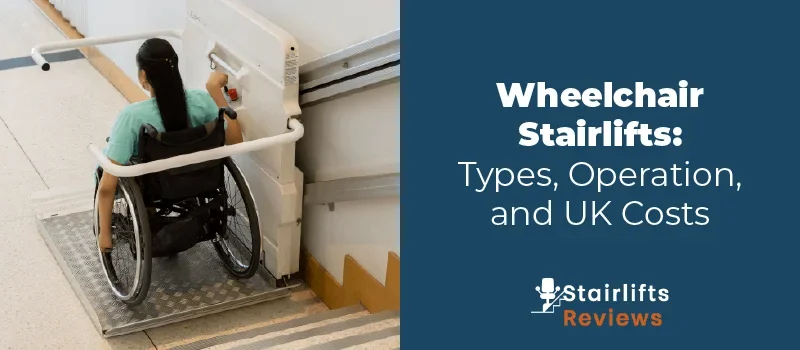
- A wheelchair stair lift is a motorised platform lift that allows wheelchair users to navigate stairs without leaving their wheelchair.
- Powered by electricity and controlled by a user-friendly interface or remote, the platform moves along the staircase on a rail system.
- Prices for wheelchair stairlifts range from £8,900 for straight models to £10,000 for curved ones and about £9,000 for outdoor versions. Through-floor lifts typically cost more, starting at £12,000.
Wheelchair users face unique challenges when selecting the right stairlift. Not all stairlift types are wheelchair-compatible, so choosing one requires careful consideration of factors like staircase design, weight limits, and accessibility. This guide covers wheelchair stairlifts, explaining their operation, types, and costs. By the end, you’ll clearly understand the best option for your mobility needs.
Navigating these considerations can be overwhelming without expert guidance. That’s where we help. We connect you with up to 4 trusted UK suppliers who offer tailored advice and free, no-obligation quotes. Skip hours of research and confidently find the right solution for your mobility needs. Click below to get started.
What’s in this guide
What is a wheelchair stairlift?
How does a wheelchair stairlift work?
Types of stairlifts for wheelchairs
How much does a wheelchair stairlift for home cost?
Can you always get a wheelchair platform lift?
Should you get a wheelchair stairlift?
FAQ
What is a wheelchair stairlift?
A wheelchair stairlift is designed to help people in wheelchairs move up and down stairs safely. Unlike regular stairlifts, which have a seat, these lifts feature a flat platform where the wheelchair can be securely placed. This makes them ideal for individuals who cannot transfer out of their wheelchairs.
These lifts include essential safety features, such as:
- Barriers to prevent movement during operation
- Anti-slip surfaces for stability
- Secure belts for added protection
Wheelchair stairlifts can be installed both indoors and outdoors, making them suitable for a variety of settings. They are compatible with straight or curved staircases and can support a wide range of weights, providing a reliable and versatile solution for improved accessibility.
How does a wheelchair stairlift work?
A wheelchair stairlift moves a flat platform along a sturdy rail or track attached to the staircase. Powered by electricity, it’s operated with simple buttons or a remote, allowing users to start or stop the lift as needed.
The platform is equipped with safety features like secure barriers and anti-slip surfaces to ensure a stable and smooth ride. Some models also include seat belts for added security. The lift operates at a steady speed of 0.1 meters per second, slower than standard stairlifts, to safely handle the platform’s size and weight.
At the destination, the lift gently stops to allow the user to exit the platform safely. For added convenience, many models feature folding platforms, which make them space-efficient when not in use.
Wheelchair stairlifts are designed to ensure safety and reliability, including:
- Obstacle detection: Sensors pause the lift if an object blocks its path.
- Battery backup: Keeps the lift functional during power outages, ensuring uninterrupted access.
Wheelchair stairlifts provide practical and reliable solutions for navigating between floors, whether you need access on straight or curved staircases at home.
Types of stairlifts for wheelchairs
Wheelchair stairlifts are available in simple straight stairlifts and more complex through-floor models, each with its own advantages. Choosing the right one depends on factors such as your home’s design, the user’s mobility requirements, and your budget.
Most wheelchair stairlifts can accommodate a weight of up to 300 kg, with through-floor lifts often supporting slightly higher capacities for larger wheelchairs or additional users.
| Wheelchair stairlift types comparison | |||||
|---|---|---|---|---|---|
| Type | Best For | Features | Cost | Fitting Time | Standards |
| Straight Rail | Straight stairs | Foldable, battery backup, non-slip ramps | £8,900–£12,000 | 4 hours | EN 81-40, CE Marked |
| Curved Rail | Curved/multi-level stairs | Custom rails, obstacle sensors | £10,000–£25,000 | 6–8 hours | EN 81-40, CE Marked |
| Outdoor | Outside stairs/patios | Durable, anti-slip, cover | £9,000–£15,000 | 4–8 hours | BS8300-2, Weatherproof |
| Through-Floor | Homes without stairs | Enclosed, vertical lift, remote | £12,000–£26,000 | 2–3 days | EN 81-40, BS EN 12182 |
Now, let’s take a closer look at each type, focusing on how they address wheelchair users’ needs.
Straight stairlifts for UK wheelchair users
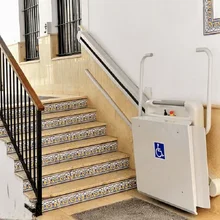
Straight wheelchair stairlifts’ tracks and simple design make them affordable and quick to install.
Best for: Homes with straight stairs and no intermediate landings.
Features:
- Smooth and steady platform movement along the rail
- Safety barriers and anti-slip flooring for wheelchair stability
- A foldable platform for compact storage when not in use
Examples: Terry Lifts Melody 1
These straight stairlifts provide a cost-effective and practical solution for wheelchair users who need safe and reliable mobility on straightforward staircases.
Curved stairlifts for UK wheelchair users
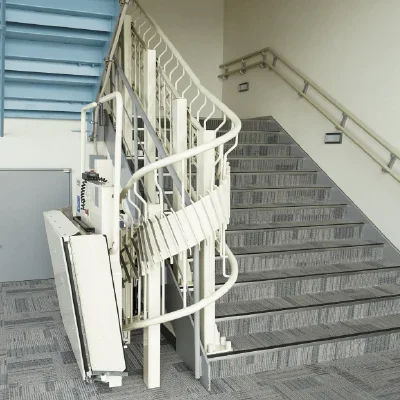
Curved wheelchair stairlifts are custom-engineered to fit your staircase’s unique bends and landings. These bespoke systems offer precise navigation and safe, smooth travel.
Best for: Staircases with multiple levels, corners, or intermediate landings.
Features:
- Tailored rails that follow curved or spiral staircases
- Advanced safety features for multi-directional movement
- Compact parking at the top or bottom for maximum stair access
Example: Supra Wheelchair Lift by TK Elevator
Outdoor wheelchair stairlifts
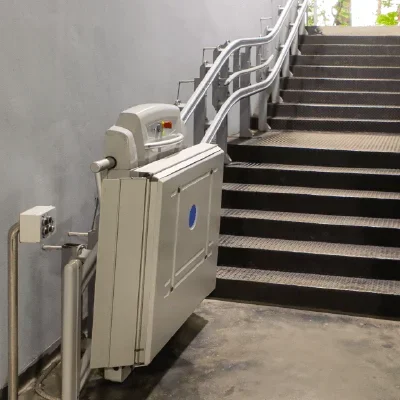
Outdoor wheelchair stairlifts are built for challenging weather conditions and offer dependable access to external stairs, gardens, or raised outdoor spaces.
Best for: Access to gardens, outdoor decks, or external staircases leading to entrances.
Features:
- Weather-resistant materials to prevent rust and corrosion
- Non-slip platforms for safe operation in wet conditions
- Protective covers to shield the lift from rain or snow
Example: Optimum 200 Exterior by Ability Lifts
Outdoor stairlifts provide long-term reliability and accessibility, enabling wheelchair users to move freely and safely outside their homes.
Through-floor wheelchair lifts
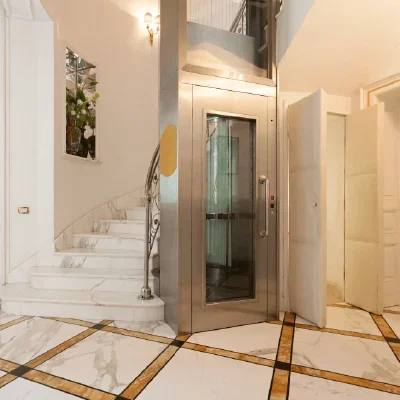
Through-floor lifts provide a direct, spacious solution for wheelchair users. They bypass stairs entirely through a floor cut-out. These vertical lifts are ideal for homes with narrow staircases or those seeking an alternative to stair-mounted options.
Best for: Homes with limited staircase space or users who prefer a lift that doesn’t occupy the staircase.
Features:
- Spacious platforms for secure wheelchair accommodation
- Smooth vertical movement between floors
- Optional remote controls or easy operation and battery backup for uninterrupted use during power outages.
Example: Terry Lifts Harmony Through-Floor Lift
Through-floor lifts are an excellent alternative to a standing stairlift. Users seeking a wider, fully enclosed option for moving between floors will benefit from their increased stability and comfort.
When choosing a wheelchair stairlift, focus on the user’s specific needs and the staircase’s design. Whether it’s a straight, curved, outdoor, or mobile stairlift for wheelchair users, each lift offers a safe and convenient way to maintain independence and mobility at home or on the go. Consulting with professional installers or stairlift companies ensures you find the perfect fit for your requirements. Get up to 4 free non-binding quotes from our network of suppliers and installers in the UK, saving you tons of research hours. Click below to get started,
How much does a wheelchair stairlift for home cost?
A wheelchair stairlift typically costs between £8,900 and £12,000 for straight rail models, £10,000 to £25,000 for curved models, £9,000 to £15,000 for outdoor models, and £12,000 to £26,000 for through-floor lifts. Installation and maintenance costs vary by lift type.
| Average Costs for Wheelchair Stairlifts | |||
|---|---|---|---|
| Type of Stairlift | Average Cost | Fitting Costs | Upkeep Costs |
| Straight wheelchair stairlift | £8,900 – £12,000 | £500 – £1,000 | £200 – £300 per year |
| Curved wheelchair stairlift | £10,000 – £25,000 | £700 – £2,000 | £300 – £500 per year |
| Outdoor wheelchair stairlift | £9,000 – £15,000 | £700 – £1,500 | £300 – £400 per year |
| Through-floor wheelchair lift | £12,000 – £26,000 | £1,000 – £2,500 | £300 – £600 per year |
Stairlift costs in the UK vary based on staircase design, features, and installation. Several factors influence the cost of specialised stairlifts for wheelchair users.
Wheelchair stairlift cost factors
Several key factors impact the total cost of a wheelchair stairlift:
- Staircase layout: A straight staircase is the simplest and most affordable to accommodate, while curved or multi-level staircases require custom rails, significantly raising the price.
- Weight capacity: Most wheelchair stairlifts support between 230 kg and 400 kg. Heavy-duty models capable of carrying larger wheelchairs or higher weights will cost more.
- Additional features: Features like folding platforms (£200–£500), remote controls (£100–£300), or waterproofing for outdoor models can increase the overall cost.
- Installation complexity: Customisation and structural adjustments for non-standard staircases add to installation costs, which can range from £500 to £2,500 depending on the lift type.
- Ongoing maintenance: Routine servicing, usually recommended twice a year, adds ongoing costs ranging from £200 to £600 annually, depending on the model and usage.
With wheelchair stairlifts costing so much, finding financial support can make a significant difference. Stairlift grants available in the UK, like the Disabled Facilities Grant (DFG), can reduce costs for eligible applicants. These grants cover various expenses, including:
- The purchase and installation of wheelchair stairlifts
- Structural modifications required for the lift
- Additional features like folding platforms or safety upgrades
| How much can you get from DGF? |
|---|
| England: Up to £30,000 |
| Wales: Up to £36,000 |
| Northern Ireland: Up to £25,000 |
Eligibility depends on household income and the applicant’s mobility needs. For those who qualify, these grants can substantially reduce or even eliminate the expense of a stairlift.
If you don’t qualify for stairlift grants, you can look into getting reconditioned stairlifts for wheelchair users. Suppliers or online sellers often sell these. These cheap stairlifts are usually 30-50 % less than new models.
Finding the right stairlift can be overwhelming, with countless options, unclear pricing, and varying features. Our service simplifies this process by connecting you with up to 4 trusted suppliers who provide accurate, non-binding stairlift quotes tailored to your needs. Skip the hours of research and compare prices, features, and warranties all in one go. Click below to get started.
Can you always get a wheelchair platform lift?
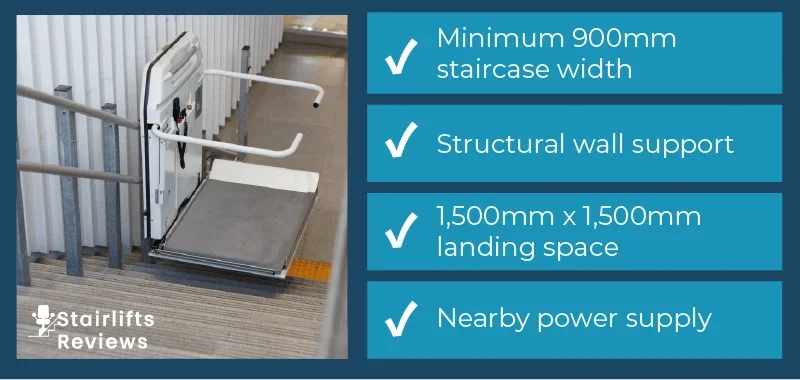
Not always. Installing a wheelchair platform lift involves several key factors, including compliance with stairlift regulations for structural modifications. Here are some factors you need to consider:
- Staircase width: Most wheelchair lifts need at least 900mm of staircase width. For narrower stairs, options like stairlifts for narrow stairs or mobile stairlifts might be more suitable.
- Structural integrity: The staircase and walls must be strong enough to support the lift’s weight. For example, certain lift models require the wall to handle a pull-out force of 472 lbs (approximately 214 kg) per bracket bolt. Suitable wall types for such installations include double 2×4 studs or concrete walls.
- Landing space: An adequate room is needed at the top and bottom for safe wheelchair manoeuvring. The UK Building Regulations Approved Document M, Volume 2, recommends a 1,500mm x 1,500mm clear landing area for wheelchair turning and access.
- Electrical supply: A nearby power source is required, although some lifts offer battery backups for uninterrupted use.
If you’re replacing an old lift, ensure that professionals carry out proper stairlift removal. This avoids potential damage to your staircase and ensures a smooth transition to your new lift.
| 📌 Alternative options |
|---|
|
Should you get a wheelchair stairlift?
A wheelchair stairlift can be a life-changing investment, but it’s not the right choice for everyone. Before deciding, critically assess your needs and circumstances:
- Practicality: Does your staircase have the required width, landing space, and structural strength to support a lift? Homes with narrow or complex stairs may face limitations without major customisations or alternative solutions.
- Cost: Can you realistically afford the purchase, installation, and ongoing maintenance? While grants or refurbished options can help reduce costs, they don’t always cover the entire expense.
- Usage: Will the lift meet your long-term mobility needs? Consider whether it accommodates your current wheelchair and any future requirements, such as increased weight capacity or additional safety features.
| 📌 Pro Tip |
|---|
| Ongoing stairlift service is essential for maintaining reliability and safety. Choose providers who offer robust warranties, regular servicing packages, and excellent aftercare support. |
Want to make the right choice without spending hours researching suppliers? Fill in our 30-second form, and we’ll connect you with up to 4 trusted stairlift companies that specialise in wheelchair lifts. Receive up to 4 free, non-binding quotes and get expert guidance to find the best option for your space. Click below to get started.







